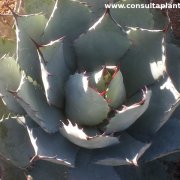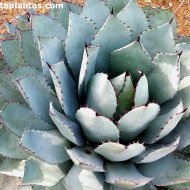Care of the succulent plant Agave parrasana or Cabbage head agave |
|
The Agave genus, a subfamily of the Agavoideae, comprises some 300 species of succulent plants native to Mexico, Central America and the Southwest of the USA. Some species are: Agave parrasana, Agave macroacantha, Agave filifera, Agave bracteosa, Agave attenuata, Agave americana, Agave stricta, Agave potatorum, Agave victoria-reginae, Agave ferox, Agave sisalana, Agave guadalajarana, Agave striata, Agave impressa, Agave deserti, Agave chiapensis, Agave palmeri, Agave vivipiara, Agave celsii , Agave shawii, Agave parryi, Agave ferdinandi-regis, Agave univittata, Agave lechuguilla, Agave datylio. Common names: Cabbage head agave, Cabbage head century plant. This species is native to Coahuila, Mexico. They are succulent plants with a compact and symmetrical shape that reach 60 cm (1.96 feet) in height. The leaves are bluish gray, short, wide and waxy in texture. They have sharp dark reddish spines on the margins. The flowers are green and appear in flower spikes several meters high above the rosette of leaves. They bloom in early summer but only do so once after several decades and die after developing suckers at the base. Due to their size they are widely used in pots for patios and terraces but they are also very interesting for rockeries, cactus and succulent gardens or as isolated specimens. Agave parrasana is grown in full sun exposure and in warm frost-free climates; They tolerate weak frosts if the soil is dry. The soil has to drain very well and better if it contains some organic matter. The pot transplant is done in spring but due to its slow growth it is only done every several years. Water when the soil has completely dried. Cabbage head century plant resists drought well. Fertilize with compost in summer and with a mineral fertilizer for cacti in mid-spring and early summer. Cabbage head agave does not usually need pruning but if there is a dry leaf we can carefully remove it because its sap is irritating. If you are in a passage area, you can trim the tines on the margins. Agave parrasana is a plant resistant to pests and diseases but not to excess humidity. The best way to propagate them is from the suckers that can be produced in the base previously put to dry for two days. |
Images of the succulent plant Agave parrasana or Cabbage head agave |
Find plants
Agave parrasana or Cabbage head agave | Care and Growing
© 2026 FavThemes




